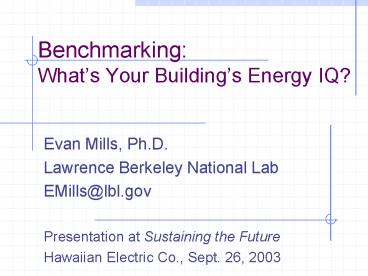Benchmarking: Whats Your Buildings Energy IQ - PowerPoint PPT Presentation
1 / 39
Title:
Benchmarking: Whats Your Buildings Energy IQ
Description:
Benchmarks Can Provide a 'Reality Check': Data Centers ... Some 'Energy' Benchmarks Don't Even Include Energy ... Standard, good, better benchmarks as defined in ' ... – PowerPoint PPT presentation
Number of Views:70
Avg rating:3.0/5.0
Title: Benchmarking: Whats Your Buildings Energy IQ
1
BenchmarkingWhats Your Buildings Energy IQ?
- Evan Mills, Ph.D.
- Lawrence Berkeley National Lab
- EMills_at_lbl.gov
- Presentation at Sustaining the Future
- Hawaiian Electric Co., Sept. 26, 2003
2
Talk Outline
- Whats Energy Benchmarking Anyway?
- Techniques
- Complications
- Applications
- Tools
- For list, see http//poet.lbl.gov/cal-arch/links/
3
Familiar Benchmarks IQ
4
Benchmarks are Everywhere
5
Huggies Diaper Size as logit Function of Child
Weight
Nice chart dubious value in real world
6
Why Benchmark?
- Establish baseline and track performance
- Validate design
- Identify maintenance and control problems
- Identify best practices set goals or standards
- Identify savings potential
- Prioritize efforts
- Educate Inspire!
7
Familiar Energy Benchmarks
Fundamental differences in approach
8
Benchmarking Can Be Done at Any Scale
- Chiller efficiency
- Global CO2/Capita
9
Choice of Benchmark Determines Conclusions
- Important to isolate sub-groups of interest
- Many ways to benchmark a given system
Source NHTSA
10
Choice of Benchmark Determines Results Actions
Average Index ofVarious Indicators (energy/studen
t, energy/sf, etc.)
ENERGY STAR Score (75 passing)
Source Norford, Palomera-Arias, and Ramsey (2003)
11
Approaches to Benchmarking
- Point-estimates (vs. population avg.)
- Statistical (bell curve vs. population)
- Point-based (vs. best practice)
- Model-based (actual vs. efficient)
- Standardized (vs. test procedure)
- Scope self-referential enterprise stock
- Timeframe historic trends vs. current
12
Lateral Longitudinale.g. Canadian Oil
Refineries
Comparing peers at one point in time
Following fleet-wide trends over time
13
Decide What is Important Before Benchmarking
Average US fuel economy increasing, then flat
Average US vehicle fuel use declining then rising
Source DOE/EIA
14
Benchmarks Can Provide a Reality Check Data
Centers
California Data Center owners claim a need of 250
W/ft2 Real data benchmarks the actual need
between 10 and 100.
15
Caveats Pitfalls
- Intensity does not equal efficiency
- Hard to avoid apples-and-oranges comparisons
(want energy per unit of service) - Normalization
- weather
- floor area
- schedule
- plug loads
- indoorconditions
- energy price
16
Examples from Hawaii
- Schools
- 32 Schools
- Average EUI 5.9 kWh/ft2-year
- Range 3.05 - 11.52 kWh/ft2-year
- Banks
- 49 Branches
- Average EUI 20.07 kWh/ft2-year
- Range 7.96 - 36.40 kWh/ft2-year
Source HECO, Thomas D. Van Liew
17
Hawaii Commercial Buildings Benchmarking Study
- Health Care 24.83 kWh/ft2-y
- Retail 25.50 kWh/ft2-y
- Apartments 10.11 kWh/ kWh/ft2-y
- Warehouse 6.76 kWh/ kWh/ft2-y
- Miscellaneous12.09 kWh/ kWh/ft2-y
- Offices 22.82 kWh/ft2-y
- Lodging 16.14 kWh/ft2-y
- Restaurants 52.88 kWh/ft2-y
- Grocery Store 53.05 kWh/ft2-y
- Education 9.00 kWh/ft2-y
- University of Hawaii13.82 kWh/ft2-y
Source HECO, Thomas D. Van Liew
18
Fast Food Restaurant EUIsHawaii
Source HECO, Thomas D. Van Liew
19
Grocery Store Energy Intensities Hawaii Average
70.9 kWh/ft2-year
Source HECO, Thomas D. Van Liew
20
Energy Intensities
Energy per meal for 36 hotels, France
Std. Dev. 34 27
19 32
Source Le Strat et al., (1999)
21
Choice of Indicator is Key
Energy per meal
Energy per unit floor area
N9
N21
N34
Source 1996 California Commercial End Use
Survey (Restaurant energy)
22
Choice of Indicator is Key
Energy per unit floor area
Energy per meal
Source The Energy Data and Modeling Center, 2001
23
Beyond Apples OrangesPippins and Granny
Smiths
Data for Switzerland. Source Balmer and
Hintermann, 2000
24
Cleanroom Energy Metrics
Tschudi and Xu, ASHRAE Transactions, KC-03-9-4
(2003)
25
Delivery of Service Levels
Tschudi and Xu, ASHRAE Transactions, KC-03-9-4
(2003)
26
Some Energy Benchmarks Dont Even Include Energy
Tschudi and Xu, ASHRAE Transactions, KC-03-9-4
(2003)
27
Cleanroom Chiller Efficiencies
Tschudi and Xu, ASHRAE Transactions, KC-03-9-4
(2003)
28
From Benchmarking to Best Practices
Laboratory Ventilation W/cfm
standard
good
better
Standard, good, better benchmarks as defined in
How-low Can You go Low-Pressure Drop
Laboratory Design by Dale Sartor and John
Weale, ASHRAE Journal
29
Benchmarks as Screening Tool
Source Lee Norford (2001)
30
(No Transcript)
31
ENERGY STAR Building Label
32
Labs21 Benchmarking Tool
Data Input
33
Labs21 Benchmarking Tool
Analysis
34
Cal-ARCH Web-based Benchmarking
35
Capturing Benchmarks with Design Intent
Documentation
36
Approach
- Decide how benchmark is to be used
- Choose type(s) of benchmarks
- Define indicators
- Be creative
- Measurement plan
- Clear definitions (e.g. floor area)
- Collect data (privacy issues)
- Establish filters normalization methods
- Learn from outliers
37
Needs
- Considerable unmet need for benchmarking
presentations that bridge the physical and
financial - More focus on component or end-use benchmarking
- Growing importance of peak demand
38
Moral of the Story
- To define an energy efficiency indicator is not
only a technical challenge, but also a
pre-structuring of the subsequent policy choice. - Aebischer, et al. (2003)
39
Correlation is Not Causation!
Advice for Traders moon-trading is by no means
a stand-alone approach































